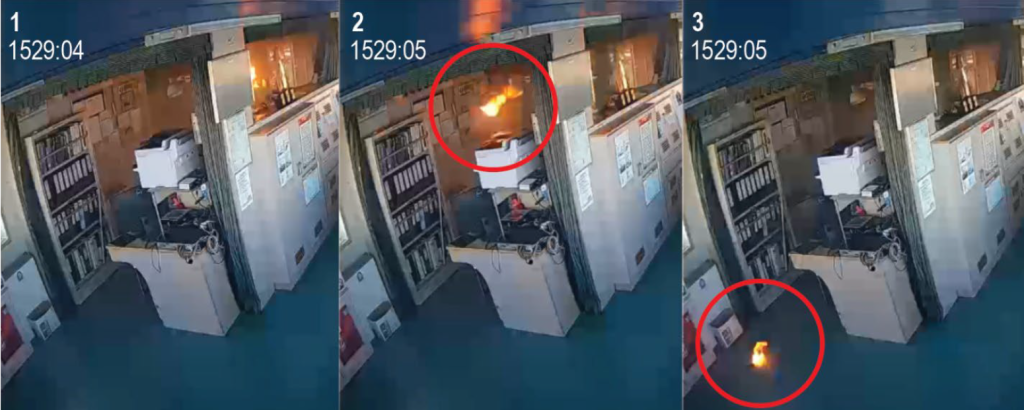NTSB: Lithium-ion battery fire destroys vessel bridge
The National Transportation Safety Board of the United States (NTSB) has published report MIR-23-23 relating to a Lithium-ion battery fire aboard a tanker. This incident highlights some of the risks and hazards associated with modern battery technologies and is highlighted to members as a matter of importance requiring further attention and discussion. Members are encouraged to download and read the full report.
What happened
A fire started on the bridge of an oil tanker whilst alongside. Fire teams from the vessel extinguished the fire in less than half an hour after it had begun. There were no injuries, but the damage caused to the vessel was estimated at US$3 million. There was extensive smoke and heat damage, and the vessel’s navigation systems, communication systems, and alarm systems were destroyed.
What went right
The emergency response of the vessel crew, including the Master who discovered the fire, was prompt and correct, including shutting the doors on a discovered fire, stopping all cargo operations, raising the alarm, isolating electrical power from the area on fire, and fighting the fire.


What went wrong
As the vessel was alongside, there was no bridge watch; no one was stationed on the bridge at the time the fire started. The first indication crewmembers had of a possible fire aboard was the loss of the CCTV feed to the monitor in the Master’s office. Had the fire occurred while the vessel was underway, there would have been personnel on the bridge, and the fire would have been immediately detected.
The vessel’s bridge did not have a smoke or fire detection system (nor was it required to), which also allowed the fire to grow undetected.
What was the the cause of the fire
The NTSB investigation determined that the probable cause was a “thermal runaway” of one of the cells in a lithium-ion battery for a UHF handheld radio on the communications table on the bridge.
Thermal runaway
A thermal runaway occurs when a battery cell overheats and combusts; it is a chemical reaction that can occur to any type of battery cell if it is damaged, shorted, overheated, defective, or overcharged.
The heat produced from a thermal runaway of a lithium-ion battery cell can exceed 600° C, which can easily cause any nearby combustible material to ignite, including adjoining cells of the same battery.
Lessons learned
- Due to the potential for rapid expansion of a Lithium-ion battery fire, detection, containment, and extinguishment are essential to prevent damage to a vessel;
- Crews can help prevent thermal runaways and ensuing fires by doing the following:
- follow manufacturers’ instructions for the care and maintenance of Lithium-ion batteries;
- properly dispose of damaged batteries;
- avoid unsupervised charging of Lithium-ion batteries;
- keep batteries and chargers away from heat sources and flammable materials.
- Ensure that Lithium-ion batteries, the devices using them, and particularly Lithium-ion battery chargers, are sourced only from reputable and recognised suppliers.
The NTSB concludes by noting that crews can attempt to extinguish a Lithium-ion battery fire with water, foam, CO2, or other dry chemical or powdered agents. However, if the battery fire cannot be extinguished, personnel should attempt to allow the pack to burn in a controlled manner; this includes watching for nearby cells that may also experience thermal runaway and extinguishing other combustibles that may catch on fire.
IMCA notes that the potential for Lithium-ion battery fires, both in our members’ work spaces and in our homes, is an increasingly topical and very serious issue. Members are encouraged to stimulate discussion about this in the workplace and to consider what appropriate steps might be taken to mitigate the risks.
Members may wish to review the following:
- USB power bank (Lithium battery) fire
- Lithium batteries: Fire following the failure of a helicopter start power unit
- Battery fire with subsequent gas explosion: Warning about lithium-ion power following ferry fire
- Fire in vessel accommodation – Overheating notebook computer
- Laptop battery fire
- LTI: Severe burn from short circuited Li-Ion battery
Safety Event
Published: 6 December 2023
Download: IMCA SF 28/23
IMCA Safety Flashes
Submit a Report
IMCA Safety Flashes summarise key safety matters and incidents, allowing lessons to be more easily learnt for the benefit of all. The effectiveness of the IMCA Safety Flash system depends on Members sharing information and so avoiding repeat incidents. Please consider adding [email protected] to your internal distribution list for safety alerts or manually submitting information on incidents you consider may be relevant. All information is anonymised or sanitised, as appropriate.
IMCA’s store terms and conditions (https://www.imca-int.com/legal-notices/terms/) apply to all downloads from IMCA’s website, including this document.
IMCA makes every effort to ensure the accuracy and reliability of the data contained in the documents it publishes, but IMCA shall not be liable for any guidance and/or recommendation and/or statement herein contained. The information contained in this document does not fulfil or replace any individual’s or Member's legal, regulatory or other duties or obligations in respect of their operations. Individuals and Members remain solely responsible for the safe, lawful and proper conduct of their operations.
